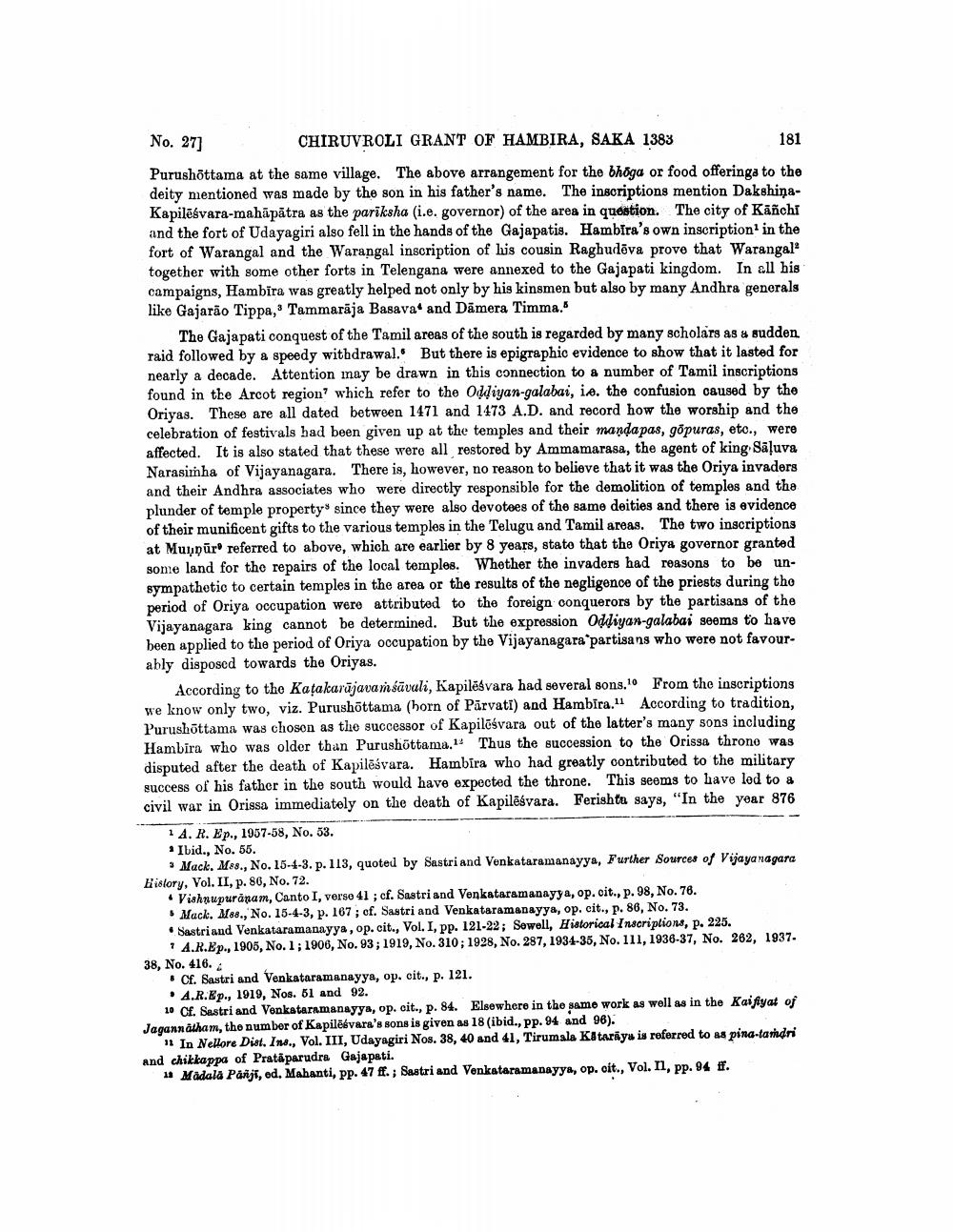________________
No. 27] CHIRUVROLI GRANT OF HAMBIRA, SAKA 1383
181 Purushottama at the same village. The above arrangement for the bhoga or food offeringa to the deity mentioned was made by the son in his father's name. The inscriptions mention DakshinaKapilēgvara-mahapatra as the pariksha (i.e. governor) of the area in question. The city of Kāñchi and the fort of Udayagiri also fell in the hands of the Gajapatis. Hambira's own inscription in the fort of Warangal and the Warangal inscription of his cousin Raghudöva prove that Warangal together with some other forts in Telengana were annexed to the Gajapati kingdom. In all his campaigns, Hambira was greatly helped not only by his kinsmen but also by many Andhra generals like Gajarão Tippa, Tammarāja Basava and Dāmera Timma.
The Gajapati conquest of the Tamil areas of the south is regarded by many scholars as a sudden. raid followed by a speedy withdrawal. But there is epigraphic evidence to show that it lasted for nearly a decade. Attention may be drawn in this connection to a number of Tamil inscriptions found in the Arcot region' which refer to the Oddiyan-galabai, ie. the confusion caused by the Oriyas. These are all dated between 1471 and 1473 A.D. and record how the worship and the celebration of festivals had been given up at the temples and their mandapas, gopuras, etc., were affected. It is also stated that these were all restored by Ammamarasa, the agent of king Sāļuva Narasimha of Vijayanagara. There is, however, no reason to believe that it was the Oriya invaders and their Andhra associates who were directly responsible for the demolition of temples and the plunder of temple property since they were also devotees of the same deities and there is evidence of their munificent gifts to the various temples in the Telugu and Tamil areas. The two inscriptions at Munpūro referred to above, which are earlier by 8 years, state that the Oriya governor granted some land for the repairs of the local temples. Whether the invaders had reasons to be unsympathetic to certain temples in the area or the results of the negligence of the priests during the period of Oriya occupation were attributed to the foreign conquerors by the partisans of the Vijayanagara king cannot be determined. But the expression Oddiyan-galabai geems to have been applied to the period of Oriya occupation by the Vijayanagara partisans who were not favour. ably disposed towards the Oriyas.
According to tho Katakarūjavamsävali, Kapilēsvara had several sons. From the inscriptions we know only two, viz. Purushottama (horn of Parvati) and Hambira. According to tradition, Purushottama was chosen as the successor of Kapilīśvara out of the latter's many sons including Hambira who was older than Purushottama. Thus the succession to the Orissa throne was disputed after the death of Kapilēśvara. Hambira who had greatly contributed to the military success of his father in the south would have expected the throne. This seems to have led to a civil war in Orissa immediately on the death of Kapilēsvara. Ferishtu says, "In the year 876
1 A. R. Ep., 1957-58, No. 53. 1 Ibid., No. 55.
Mack. Ms., No. 15-4-3. p. 113, quoted by Sastri and Venkataramanayya, Further sources of Vijayanagara History, Vol. II, p. 80, No. 72.
• Vishnupuranam, Canto I, verso 41 ; cf. Sastri and Venkataramanayya, op. cit., p. 98, No. 78.
Mack. Mos., No. 15-4-3, p. 167; of. Sastri and Venkataramanayya, op. cit., p. 86, No. 73. • Sastriand Venkataramanayya, op. cit., Vol. I, pp. 121-22; Sowell, Historical Inscriptions, p. 225.
* A.R.Bp., 1906, No. 1: 1906, No. 93; 1919, No. 310; 1928, No. 287, 1934-35, No. 111, 1936-37, No. 262, 1937. 38, No. 416.
Cf. Sastri and Venkataramanayya, op. cit., p. 121. .A.R.Ep., 1919, Nos. 61 and 92.
10 CF. Sastri and Venkataramanayya, op. cit., p. 84. Elsewhere in the same work as well as in the Kai fiyat of Jagannatham, the number of Kapilēgvars's sons is given as 18 (ibid., pp. 94 and 96).
11 In Nellore Dist. Ins., Vol. III, Udayagiri Nos. 38, 40 and 41, Tirumala Kataräys is referred to as pina-tandri And chikkappa of Pratäparudra Gajapati.
1 Mädala Panji, od. Mahanti, pp. 47 ff.; Sastri and Venkataramanayya, op. oit., Vol. 11, pp. 94 #f.




